Franco-Dutch War
| ||||||||||||||||||||||||||
The Franco-Dutch War (1672–78), often called simply the Dutch War (French: Guerre de Hollande; Dutch: Hollandse Oorlog), was a war fought by France, Sweden, Münster, Cologne and England against the Dutch Republic, which was later joined by the Austrian Habsburg lands, Brandenburg-Prussia and Spain to form a Quadruple Alliance. The war ended with the Treaty of Nijmegen, by which Spain ceded the Franche-Comté and some cities in Flanders and Hainaut to France, while France returned some of its conquests (Maastricht and the Principality of Orange) to the Dutch.
The year 1672, when a full invasion of English, French and German forces took much of the Dutch Republic by surprise, is often referred to as het Rampjaar ("the Disaster Year") in Dutch.[1]
Origins
In the 1560s, the future Dutch Republicans formed an alliance with France.[2] The alliance lasted for a century. Louis XIV of France considered the Dutch to be trading rivals, seditious republicans and Protestant heretics – but military allies nevertheless. This was until the Dutch signed the Triple Alliance (1668) with England (against whom they had just fought a war) and Sweden in support of Spain (another recent foe), and countered French expansion in the Spanish Netherlands (War of Devolution). It was clear that Louis had to deal with the Republic before making another move on the Spanish Netherlands.[3]
Louis prepared for war against the Republic. His first and primary objective was to gain the support of England.[4] England felt threatened by the Dutch naval power; it had therefore fought the first (1652-54) and second (1665-67) of the Anglo-Dutch Wars. Thus, the English did not need much encouragement to leave the Triple Alliance, but to help things along, Louis agreed to send financial support in the amount of three million pounds annually.[5] Sweden agreed to indirectly support the invasion of the Republic, by threatening Brandenburg-Prussia if that state should intervene.
Preparations
Measures taken by Louvois, Louis' Secretary of War, allowed France to mobilise about 180,000 men. Of these about 120,000 would be used directly against the Republic. The bulk of the French army was divided into two bodies. The body led by field marshal Turenne was stationed in Charleroi, then France. The body led by Condé waited in Sedan.[6] Both would march through the pro-France Prince-Bishopric of Liège, join near Maastricht and gain the Rhine.
On the Rhine, a third body would be waiting. It had been created from the allied armies of Münster and Cologne and was placed under the command of Luxembourg. The combined armies would then attack the duchy of Cleves and the region of Nijmegen.[6] A fourth body was to be an English expeditionary force, but English landings would not take place (see Third Anglo-Dutch War). The alliances clashed when England declared war on the Republic, on 7 April 1672.
War
Louis arrived in Charleroi on 5 May 1672.[6] Turenne's 50.000 men set off on 11 May.[6] Arrived at Visé, Louis decided not to lay siege to Maastricht but only to occupy the surrounding forts of Tongeren, Maaseik and Valkenburg so its garrison stayed bottled up.[6] Moving along the Rhine, Rheinberg, Wesel, Burick and Orsoy were taken.[7] Turenne then took Nijmegen (3-9 July), with 4,000 infantry and 400 cavalry, and from there Fort Crèvecœur near 's-Hertogenbosch, which fell after only two days.[8]
In view of these defeats, the public panicked and rioted. The leading Dutch politicians Johan and Cornelis de Witt were lynched by an angry Orangist mob,[9] following rumours (never substantiated) that they were planning the assassination of William of Nassau (the later William III). On 4 July, William was acclaimed stadtholder.[9] As the French had promised the major cities of Holland to the English, they were in no hurry to capture them. The French tried to gain sixteen million guilders from the Dutch in exchange for a separate peace. This demand and other conditions posed by the French stiffened Dutch resistance. Negotiations gave the Republic time to finish the inundations along the Dutch Water Line, started on 22 June 1672.[10] Luxembourg laid siege to Groningen but failed to take it.[8] An attempt was made to invade the Republic by sea; this was thwarted by Admiral Michiel de Ruyter in four strategic victories against the combined Anglo-French fleet (see Third Anglo-Dutch War). The first of these naval victories was the Battle of Solebay.[8]
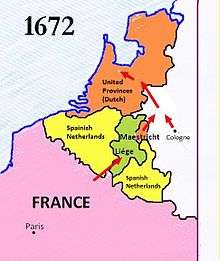
Already, allies had joined the Dutch cause: Frederick William of Brandenburg-Prussia,[10] Emperor Leopold and Charles II of Spain.[4] Louis was forced to abandon his plans of conquering the Dutch and revert to a slow, cautious war of attrition around the French frontiers. Turenne broke off his offensive against the Dutch in August 1672 and proceeded to Germany with 25,000 infantry and 18,000 cavalry.[10] The forces of Frederick William and Leopold joined to form a combined force of 25,000 men under the command of Raimondo Montecuccoli. In late January 1673, Turenne heard that Montecuccoli was crossing the Rhine at Koblenz. He pushed him all the way back across northern Germany. Eventually, Frederick William pulled Brandenburg-Prussia out of the war[11] on 6 June 1673.[12]
In the summer campaign of 1673, Louis turned back to the Dutch front and besieged Maastricht, a huge fort on the Meuse and an impediment to his operations in the Netherlands.[13] Louis had a fondness for planning and executing sieges, especially the detail of sieges.[14] On 10 June 1673, Louis joined his army of 45,000 men and 58 cannons surrounding Maastricht.[15] He proceeded to oversee the digging of trenches and the establishment of siege lines, which was complete by 14 June 1673.[16] One of the commanders who died in the heavy fighting at the siege was Charles d'Artagnan who commanded the king's musketeers.[16] The fortress surrendered on 30 June 1673. Present at the siege of Maastricht was an English delegation of military officers led by the Duke of Monmouth,[17] the illegitimate son of Charles II of England by Lucy Walter. Among the officers was Captain John Churchill, who together with Monmouth and the other English soldiers present, led the first attack on Maastricht on the night of 27 June 1673.[18] Indeed, Churchill was wounded while at Monmouth's side during the fighting.[19] So impressed was Louis with the bravery of English troops and Marlborough that he publicly thanked them during the great parade celebrating the capture of Maastricht.
.jpg)
During the summer campaign of 1673, Turenne had the thankless task of trying to contain Leopold's troops under the command of Raimondo Montecuccoli.[13] Montecuccoli finally joined with the Dutch troops of William III to besiege and take the city of Bonn from the French.[20] In August 1673, The Habsburg monarchies of Spain and the Holy Roman Empire signed a formal alliance with the Republic that required that France be returned to her boundaries of 1659. This alliance was strengthened in October by Charles IV of Lorraine.[20] Imperial and Dutch troops conquered the town of Naarden from the French on 13 September.[21] The Spanish who had yet to formally enter the war, declared war on the French on 16 October.[22] At about the same time Frederick William re-entered the war against France.[11] The position of Louis at this stage was bad enough, but it worsened when England made a separate peace, the Treaty of Westminster, with all of the nations arrayed against France on 19 February 1674.[21] Charles II had been forced into making peace with the Republic by the Parliament which returned to session in October 1673.[23]
.jpg)
The English Parliament had initially been enthusiastic about the war. However, a number of events were beginning to turn Parliament against the war by early 1673. First, the naval war had not been going well for the English and Parliament was all too aware of how dangerous a war at sea was to the trading interests of England, especially against a strong naval power like the Dutch.[24] Secondly, the opening of the dykes in the Netherlands ground the French campaign to a halt, so that the Dutch could devote all their attention to the naval campaign against England.[23] Thirdly, the prospects of the French winning the war became worse when both the Holy Roman Empire and Spain entered the alliance against the French.[20] Fourthly, the religious issue, once again, raised its head in England when Charles II allowed his resolutely papist brother, James, the Duke of York and direct heir to the throne, to marry the Catholic princess Mary of Modena.[23] Parliament found this wedding to be obnoxious to its Protestant sensibilities and demanded an immediate withdrawal of Charles' Declaration of Indulgence, as a condition of any further funds being voted for the war. Indeed, feelings were running so high against any attempt to return England to Catholicism, that Parliament also demanded a Test Act be instituted in England which would prevent any Catholic from holding public office in England.[24] Accordingly, Charles II was required to yield to the will of Parliament on both of these measures to obtain funds to support the English troops still involved in the war. In the end, through the mediation of Spain, England eventually signed a peace treaty with the Dutch on 19 February 1674.[25] This peace treaty ended England's official involvement in the war. However, about 6,000 English soldiers joined the French army and continued to fight in the war under the pay of French. Among these English troops was John Churchill (as noted above—the future Duke of Marlborough).[26]
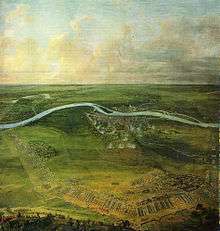
Meanwhile, in the North American colony of New France, Jurriaen Aernoutsz, a Dutch navy captain from Curaçao, conquered the capital of Acadia in 1674, renaming the colony New Holland. Although the Dutch never fully gained control of the territory, they continued to claim sovereignty over Acadia on paper, for the duration of the war, even appointing Cornelius Van Steenwyk as its nominal governor. In actual practice, however, the territory remained under French control. By the time of the Treaty of Nijmegen, however, the Dutch claim to Acadia was simply abandoned. In 1673, during their war against England, the Dutch also occupied New York City, which had formerly been the Dutch settlement of New Amsterdam, and renamed in New Orange, but returned it to the English when the English left the war.
Turenne spent the winter of 1673–1674 in Alsace and the Palatinate. Quartering these French soldiers over the entire winter was so unpopular with the local populace that the Electoral Palatinate joined the Imperial forces.[27] Turenne began the summer campaign on 12 June 1674 with 6,000 cavalry, 2,000 infantry and 6 cannons. English soldiers had been attached to Turenne's forces, as noted above, under command of Churchill. To make his new command official, however, Churchill needed to be raised to the rank of colonel. The suggestion for this promotion within the ranks came from his fellow English officers, largely the Duke of Monmouth.[28] Because Churchill and all other English soldiers on the continent were now officially part of the French army, he needed to be presented at Versailles and receive the personal approval of King Louis before he could receive his colonelcy. His appointment as colonel in the French army was granted on 3 April 1674.[28]
Turenne marched his army toward Philippsburg where he crossed the Rhine on 14 June 1674, hoping to strike General Enea Caprara and Duke Charles IV before they could be reinforced by the Imperial army under the command of Field Marshal Alexander von Bournonville. Turenne's forces met Imperial troops on 16 June 1674 on a piece of high ground just across the Elsenz stream near the town of Sinsheim. The Battle of Sinsheim was a complete victory for Turenne,[29] but the Imperial troops had delayed Turenne long enough to allow Bournonville's army to reinforce the forces of General Caprara and the Duke of Lorraine at Heidelberg. Thus, Turenne marched right up to the gates of Heidelberg.[30]
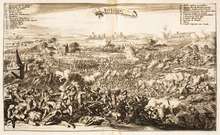
Turenne was eventually forced to retreat to the western Rhine bank.[31] Near Neustadt, he was reinforced with fresh troops. Memories of Sinsheim, however, served Turenne well. As he made ready to cross the Neckar river, Imperial troops on the other side fled in a precipitous retreat that exposed the whole of the Palatinate to Turenne's army.[29] Bournonville's army marched south and captured the neutral city of Strasbourg. He was now able to use this city as a base to march into the heart of Alsace, but before doing so he awaited Frederick William's 20,000 men. Turenne was determined to strike Bournonville before the enemy forces could link up. He marched his army all night on 2–3 October 1674 to reach the town of Molsheim. On 4 October 1674, he left his army's baggage at Molsheim to advance against Bournonville.[32] Turenne surprised Bournonville's army as it was still lining up behind the town of Entzheim.[33] Even as he observed Bournonville's troops, Turenne noticed that its left wing formation was moving forward into a small wooded area. Turenne recognised this as a key position.[33] Turenne immediately ordered troops of his right wing under the command of brigadier Louis-Francois, marquis of Boufflers, into the woods to capture the position before the Imperial troops had an opportunity to establish themselves in the woods. Among the troops that made up Turenne's right wing was the battalion of troops (now made up of three regiments) led by John Churchill.[34] In the attack, Churchill would very nearly succeed in clearing the entire woods before Bournonville brought up artillery on the flank of the woods and forced Churchill out of the woods.[35]
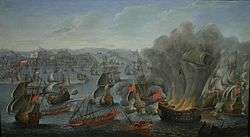
Also in 1674, there was fighting along the Pyrenees, as Frederick von Schomberg led a small French army against the Spanish in Roussillon.[36] Even with the 10,000 local militia troops that Louis added to Schomberg's army, Schomberg felt himself disadvantaged against the Spanish. The Spanish forces under the command of General San Germán took Fort Bellegarde on the spine of the Pyrenees. On 19 June 1674, the French suffered another defeat at Maureillas.[36] Things went somewhat better for the French after a revolt by the citizens of Messina, Sicily, against their Spanish overlords about an increase in taxes, required San Germán to hold back a number of his troops to be ready for shipment to Sicily.[36] In 1675, Schomberg was able to retake Fort Bellegarde.
By the end of 1675, even those English troops that had been serving in the French armies as mercenaries were being called home. By December 1675, Marlborough and all his troops were in Paris on their way home.[37] Also in 1675, the Great Condé was becoming so incapacitated with gout and other infirmities, that he was unable to carry out all his duties without help. Consequently, Louis was required to raise a new army with a new general. Accordingly, between 5,000–6,000 men were raised and placed under the command of Marshal François-Joseph, marquis of Créqui.[38] In early December 1674, Turenne prepared to go out on this winter campaign. On 29 December 1674, he surprised and smashed the Imperial cavalry at Mulhouse.[39] Then, Turenne marched for Colmar where he expected to meet the army of Frederick William, who had managed to gather 30,000 to 40,000 of his men out of winter quarters and take up a defence line between Colmar and Turkheim. However, the latter army still had not gelled in place on 5 January 1674, when Turenne attacked with 30,000 French troops.[40] Turenne feigned an attack to the right and then to the center, while hidden by the terrain, some of his infantry moved around to the left and took the town of Turkheim on Frederick William's flank.[36] An attempt to retake Turkheim was defeated under heavy fire from the French and an infantry charge. Frederick William retreated back to Strasbourg and crossed over to the eastern Rhine bank.[36]

The Spanish wanted to cut the French supply route. They therefore had been attempting to retake Maastricht ever since its fall. The Prince-Bishopric of Liège refusing to join the anti-French coalition, the Spanish tried to support an anti-French uprising (January 1674) and took military control of the cities of Huy and Dinant.[41] Finally on 31 March 1675, just when an anti-French uprising seemed most imminent, Maastricht sent a garrison of 1,500 soldiers to the city of Liège.[42] From France, a fresh army marched in and retook Dinant (21–29 May 1675) and Huy (31 May–6 June 1675).[43] Likewise the town of Limbourg was taken by the French after a siege lasting from 13 June until 21 June 1675.[44] Meanwhile, Turenne was trying to protect the Alsace from invasion by Montecuccoli. On 27 July 1675, Turenne caught Montecuccoli's army (Battle of Salzbach). However, during an Imperial artillery barrage, a cannonball landed among a group of French officers and killed Turenne.[45] Though defeated in this battle, Montecuccoli and his imperial forces were victorious in the following campaign, driving the French back to the Vosges mountains. Meanwhile, Charles IV and the duke of Brunswick-Lüneburg managed to defeat a French army in the Battle of Konzer Brücke.
There were two other significant changes in the cast of military leaders during the year. On 17 August 1675, Charles IV died and was succeeded by his son, Charles V. He became the main Imperial commander and in this year managed to win the Siege of Philippsburg against the French. The city surrendered in September. At the end of the campaign season the Great Condé was forced to retire from all military duties because of his infirmities. After eleven years in retirement, he died on 11 December 1686.
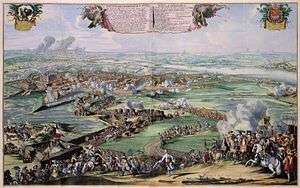
In the last three years of the war, from 1676 through 1678 there was more siege activity than field battles. Furthermore, all the activity of the last three years achieved little change from what had already been achieved by the end of 1675. Louis had largely gone over to the defense in his aims for the war.[46] However, there also were some noteworthy naval actions in 1676. On 2 June 1676, the French navy under Louis-Victor Vivonne, duke de Rochechouart destroyed a Dutch fleet.[47] By this naval victory France, temporarily, achieved naval supremacy in the Mediterranean. In the previous naval action, Dutch admiral De Ruyter had already been killed during the inconclusive Battle of Augusta against a French fleet on 22 April 1676.[48] In the east, led by Marshal Crequy, the French army pushed the imperials back, retook most of Alsace and the front stabilized on the Rhine.
By 1678, Louis, once again, managed to break apart his opponents' coalition (as he had done to the Triple Alliance). However, Louis continued to be worried that the nations of Europe might still consolidate against him. In October 1677, Mary, daughter of James, Duke of York married William of Orange, current the Stadtholder of the Republic. This was an ominous sign of a rapprochement between the Dutch and the English. So, Louis was in a hurry to shore up his military position before England re-entered the war, this time as enemy. Accordingly, the summer campaign of 1678 began very early in the spring. Louis moved his army into the Spanish Netherlands and besieged Ghent on 1 March 1678.[49] Louis was afraid that the anti-French parliament in England would act any day to force King Charles II of England back into the war. Ghent fell to the French on 10 March 1678. The French army then besieged Ypres on 15 March 1678. Ypres surrendered on 26 March 1678.[49]
The English sent an expeditionary force to Flanders in 1678, under the command of the Duke of Monmouth, to support the Dutch against the French, it did not see much action but some British units saw action at the Battle of Saint-Denis (the last battle of the war).[50]
The victories at Ghent and Ypres had gained Louis a strong bargaining position for France at the peace talks. France gained considerable territories under the terms of the Treaty of Nijmegen which was signed by the Dutch and France on 10 August 1678, but less than it aimed for.[51] Most notably, the French acquired the Franche-Comté and various territories in the Spanish Netherlands.[52] Nevertheless, the Dutch had thwarted the ambitions of two of the major royal dynasties of the time: the Stuarts and the Bourbons.
The war marked the beginning of a rivalry between two powerful men in Europe: William III (who would later invade England in support of the claim of his wife, Queen Mary II, to the English throne as part of the "Glorious Revolution") and Louis XIV. They, along with their respective allies, would be pitted against each other in a series of wars in the years that followed.
1678, peace and consequences
In 1678 Louis continued his conquests at the expense of the Spanish Netherlands, capturing Ghent and Ypres (25 March). The talks progressed in Nijmegen, but were thwarted by the French decision to protect Swedish interests. But with a new French victory in July, the United Provinces signed the Peace of Nijmegen in August 1678. Other peace treaties are signed with the other contenders in the coming months, where the decadent Spain would come out defeated, losing to France the Franche-Comté and most of the various captured cities of the Spanish Netherlands.[52] The United Provinces, which ran the risk of being wiped out in 1672, could celebrate the reduction of some tariffs in its trade with France. Sweden, whose military tradition was not sufficient to stop the rise of Berlin, managed to leave the conflict with territorial losses negligible. Although the outcome was at first glance inconclusive, it would have great importance for the events of the next 40 years. France, which in the final years of the war fought almost alone against a powerful coalition, left the episode as a great military power of continental Europe. Following the war, Louis XIV began to be referred to as the "Sun King."[53] Following the war, the United Provinces started to show signs of decay; their pre-eminence as a naval power would eventually be ceded to England. Ruled by William of Orange after the Glorious Revolution, England was to become the sworn enemy of France. Spain and Sweden, shy participants in this conflict, lost importance and would suffer great territorial losses in the following decades.
The song "Auprès de ma blonde" or "Le Prisonnier de Hollande" ("The Prisoner of Holland"), in which a French woman grieves for her beloved who is held prisoner by the Dutch, appeared during or soon after the Franco-Dutch War – reflecting the contemporary situation of French sailors and soldiers being imprisoned in the Netherlands.
Chronological list of key events
- 1672 – Battle of Sole Bay (7 June – Third Anglo-Dutch War)
- 1673 – Battle of Schooneveld ( 7 and 14 June – Third Anglo-Dutch War)
- 1673 – Siege of Maastricht (13 – 26 June)
.jpg) The Battle of Solebay, May 1672
The Battle of Solebay, May 1672.jpg) The siege of Rheinberg by the French, 6 June 1672
The siege of Rheinberg by the French, 6 June 1672 - 1673 – Battle of Texel (21 August – Third Anglo-Dutch War)
 The Battle of the Texel, August 1673
The Battle of the Texel, August 1673 - 1673 – Siege of Bonn (end of October – 15 November)
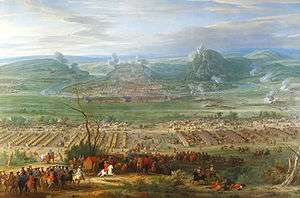 The Siege of Besançon in 1674
The Siege of Besançon in 1674 - 1673 – Siege of Werl
- 1673 – Battle of Heringen
- 1674 – Occupation of Acadia
- 1674 – Siege of Besançon (April – May)
- 1674 – Battle of Sinsheim (or Sinzheim) (16 June)
- 1674 – Battle of Ladenburg (7 July)
- 1674 – Battle of Seneffe (11 August)
- 1674 – Battle of Enzheim (4 October)
- 1674 – Battle of Mulhouse (under Muehlhausen) (29 December)
- 1675 – Battle of Turckheim (5 January)
- 1675 – Battle of Fehrbellin (28 June – Brandenburg-Swedish War)
- 1675 – Battle of Nieder Sasbach (27 July)
- 1675 – Battle of Konzer Brücke (11 August)
- 1676 – Battle Alicudi (8 January)
- 1676 – Battle of Messina (25 March)
- 1676 – Battle of Golfo di Augusta (22 April)
- 1676 – Battle of Jasmund (25 May – Danish-Swedish (Scanian) War of 1675–1679)
- 1676 – Battle of Öland (11 June – Scanian War of 1675–1679)
- 1676 – Battle of Palermo (2 June)
- 1676 – Battle of Halmstad (17 August – Scanian War of 1675–1679)
- 1676 – Battle of Lund (4 December – Scanian War of 1675–1679)
- 1677 – Siege of Valenciennes (28 February – 17 March)
- 1677 – Siege of Cambrai (28 March – 17 April)
- 1677 – Battle of Cassel (11 April)
- 1677 – Battle of Køge Bay (1 July – Scanian War of 1675–1679)
- 1677 – Battle of Landskrona (24 July – Scanian War of 1675–1679)
- 1677 – Battle of Kochersberg (7 October)
- 1678 – Siege of Offenburg
- 1678 – Siege of Ypres (18 – 25 March)
- 1678 – Battle of Rheinfelden (6 July)
- 1678 – Battle of Gengenbach (23 July)
- 1678 – Battle of Saint-Denis (14 August)
See also
- War of Devolution (1667–68)
- War of the League of Augsburg or the War of the Grand Alliance (1688–97)
- War of the Spanish Succession (1701–14)
- For the "Dutch wars" of England, see Anglo–Dutch Wars
- For the quadruple alliance of 1718–1720, see War of the Quadruple Alliance
- Second Genoese-Savoyard War (1672–1673)
- Scanian War (1675–79)
- Auprès de ma blonde (French song derived from this war)
- Wars and battles involving Prussia
- Action of 1678
References
- ↑ 1672 Disaster Year, Rijksmuseum
- ↑ Wolf 1962, p. 316.
- ↑ Sommerville 2008.
- 1 2 Smith 1965, p. 200.
- ↑ Lynn 1999, pp. 109–110.
- 1 2 3 4 5 Lynn 1999, p. 113.
- ↑ Lynn 1999, pp. 113–114.
- 1 2 3 Lynn 1999, p. 115.
- 1 2 Lynn 1999, p. 114.
- 1 2 3 Lynn 1999, p. 117.
- 1 2 Koch 1978, p. 61.
- ↑ Lynn 1999, p. 118.
- 1 2 Churchill 1933, p. 84.
- ↑ Lynn 1999, p. 71.
- ↑ Lynn 1999, p. 119.
- 1 2 Lynn 1999, p. 120.
- ↑ Churchill 1933, pp. 88–98.
- ↑ Churchill 1933, p. 89.
- ↑ Churchill 1933, p. 91.
- 1 2 3 Lynn 1999, p. 121.
- 1 2 Lynn 1999, p. 122.
- ↑ Wolf 1962, p. 319.
- 1 2 3 Churchill 1933, p. 95.
- 1 2 Churchill 1933, p. 94.
- ↑ Churchill 1933, p. 96.
- ↑ Churchill 1933, p. 98.
- ↑ Lynn 1999, p. 128.
- 1 2 Churchill 1933, p. 99.
- 1 2 Lynn 1999, p. 129.
- ↑ Lynn. p. 129.
- ↑ Lynn 1999, p. 130.
- ↑ Lynn 1999, p. 131.
- 1 2 Churchill 1933, p. 102.
- ↑ Lynn 1999, p. 132.
- ↑ Churchill 1933, p. 103.
- 1 2 3 4 5 Lynn 1999, p. 135.
- ↑ Churchill 1933, p. 105.
- ↑ Lynn 1999, pp. 132–133.
- ↑ Lynn 1999, p. 133.
- ↑ Lynn 1999, pp. 133–135.
- ↑ Lynn 1999, p. 136-137.
- ↑ Lynn 1999, p. 137.
- ↑ Lynn 1999, pp. 138–139.
- ↑ Lynn
- ↑ Lynn 1999, p. 141.
- ↑ Lynn 1999, p. 144.
- ↑ Lynn 1999, pp. 148–149.
- ↑ Lynn 1999, p. 148.
- 1 2 Lynn 1999, p. 153.
- ↑ Childs 2013, pp. 185–190.
- ↑ Lynn 1999, p. 154.
- 1 2 Mitford 1966, p. 32.
- ↑ Lynn 1999, p. 159.
Bibliography
- Childs, John (2013), Army of Charles II, Routledge, pp. 185–190, ISBN 978-1-134-52859-2
- Churchill, Winston S., Marlborough: His Life and Times, Book I (Chicago: University of Chicago, 1933). ISBN 0-226-10633-0.
- Koch, H. W., A History of Prussia (Dorset Press: New York, 1978).
- Lynn, John A., The Wars of Louis XIV: 1667–1714 (Longman Publishers: Harlow, England, 1999).
- Mitford, Nancy, The Sun King: Louis XIV at Versailles (Harper & Row Publishers: New York, 1966).
- Sommerville, J. P. (16 January 2008), The wars of Louis XIV
- Smith, Rhea Marsh, Spain: A Modern History (University of Michigan Press: Ann Arbor, Michigan, 1965).
- Wolf, John B., The Emergence of European Civilization (Harper & Row: New York, 1962).
Further reading
- Bély, Lucien, La France Moderne (Paris: Presses Universitaires de France, 1994).
- Eggenberger, David. An Encyclopedia of Battles (New York: Dover Publications, 1985). ISBN 0-486-24913-1.
- Pujo, Bernard, Le Grand Condé (Éditions Albin Michel, 1995)
- Souza, Marcos da Cunha e et al., História Militar Geral I (Palhoça: UnisulVirtual, 2009).
- Tarnstrom, Ronald, The Sword of Scandinavia (Lindsborg: Trogen Books, 1996).
- Weygand, General, Turenne (Paris: American Edition, 1929).
External links
| Wikimedia Commons has media related to Franco-Dutch War. |
